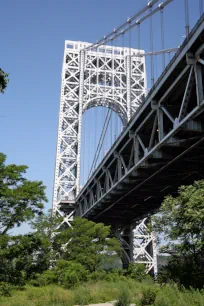The George Washington Bridge connects Manhattan with New Jersey over the Hudson River. Once the world’s longest suspension bridges, it is one of New York’s most famous and undoubtedly most impressive bridges.

New York boomed during the 1920s, and its population doubled between 1900 and 1930 to seven million. Car ownership increased exponentially and by 1930 New York was the most congested city in America and its streets were constantly clogged up. To relieve congestion, plans were drawn up to build new highways, tunnels and bridges.
Construction



The construction of the George Washington Bridge, which started in 1931, was one of these large infrastructure projects aimed to relieve congestion in New York City. The bridge’s location was carefully chosen between a bluff in Manhattan’s Washington Heights neighborhood and Fort Lee in New Jersey across the Hudson River. The steep riverbanks allowed for shorter ramps and lowered its overall construction costs.
The engineer chosen for the design of the bridge was Othmar Hermann Ammann, a Swiss immigrant who had moved to the US in 1904. He was assisted by Cass Gilbert, the architect best known for his Woolworth Building. Construction of the George Washington Bridge started in 1927 and the bridge opened to traffic in 1931.
The World’s Longest
The George Washington Bridge was an engineering marvel of its time, and its fame stems from the major leap forward it represented. With a span of 1067 meters or 3501 feet, the bridge was almost twice as long as the world’s then-longest bridge, the Ambassador Bridge in Detroit.
The George Washington Bridge would hold the title of longest suspension bridge until 1937, when it was surpassed by the Golden Gate Bridge in San Francisco. Today, the bridge isn’t even the longest bridge in New York (that title goes to the Verrazano-Narrows Bridge), but it remains a favorite of architecture enthusiasts and is only surpassed in fame by the inevitable Brooklyn Bridge.
Design
The iconic towers of the George Washington Bridge rise 604 feet (184 meters) above the water. Cass Gilbert wanted to clad the towers in granite and create observatories in the towers, but due to budget constraints this was never realized. Instead, the steel framework is visible – and that is part of the bridge’s appeal. Designed like monumental arches, they are truly impressive, especially when approaching the bridge to cross the river.

The bridge initially had six lanes for car traffic, later expanded to eight. A lower deck was added in 1962 – following original plans by Ammann, bringing the total number of lanes to fourteen.
Little Red Lighthouse
Near the east tower of the George Washington Bridge stands a small, picturesque lighthouse known as the Little Red Lighthouse. Officially known as Jeffrey Hook’s Lighthouse, it was originally located in New Jersey and moved to this spot in 1921. The lighthouse was made famous by a children’s book published in 1942: ‘The Little Red Lighthouse and the Great Gray Bridge’, written by Hildegarde Swift.

